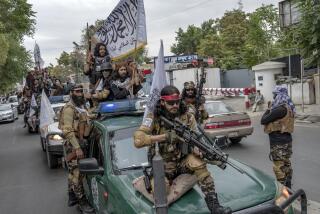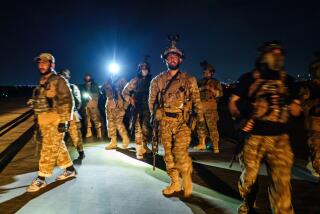Afghan Opposition Seizes Key City
TERMEZ, Uzbekistan — Opposition forces battled their way into the northern Afghan city of Mazar-i-Sharif on Friday, sending Taliban forces fleeing in a conquest that marks the biggest victory in the monthlong war in Afghanistan.
By this morning, residents said that the flag of the opposition forces was flying throughout the city and that music--long forbidden by the Taliban--was blaring in the streets. The Northern Alliance’s radio station, Radio Balkh, was back on the air.
“It’s like a holiday,” a shopkeeper in central Mazar-i-Sharif said by telephone this morning. “Everyone is coming into the city center. They are almost dancing in the streets.”
In Kabul, the capital, Taliban Defense Minister Obaidulla confirmed that the militia had lost control of the strategic northern city.
“Mazar-i-Sharif has fallen,” announced Mohammed HashamSaad, the ambassador for the Northern Alliance in neighboring Uzbekistan.
Despite the Taliban’s concession, the Pentagon wouldn’t confirm the alliance’s seizure of the city. Earlier, Pentagon spokeswoman Victoria Clarke called the reports of the capture “encouraging.”
By this morning, commanders said they were in complete control of the city, including the former Taliban command center and the airport. They said they had also chased the retreating Taliban more than 15 miles to the east and were strengthening positions around a strategic crossroads where the road to Kabul intersects the road north to Uzbekistan.
“The city was captured quietly,” Khoji Habib, a top deputy to Northern Alliance commander Gen. Abdul Rashid Dostum, said by satellite phone from Mazar-i-Sharif. “After we entered, there was hardly any shooting.”
The capture of Mazar-i-Sharif has enormous symbolic value for the Northern Alliance, which until 1998 used the city as its de facto capital.
At a Pentagon briefing Friday, Clarke described the city as a potential land bridge linking alliance troops to humanitarian aid and other--presumably military--supplies in Uzbekistan. Alliance leaders said they expect the Uzbeks to open a bridge soon that has remained closed to Afghanistan since the Taliban seized control of the city in 1998.
The city, just 20 miles from the border with Uzbekistan, has long served as an important transportation and trade route, lying on Afghanistan’s main north-south corridor.
When the Taliban took control of Kabul in 1996, many government officials and intellectuals fled north to Mazar-i-Sharif, making it the center of the anti-Taliban opposition. Since then, control of the ethnically mixed city has changed hands three times.
The Northern Alliance is also facing off against the Taliban north of Kabul. U.S. bombing of Taliban positions along that front has intensified steadily over the past few days. Bombing started again today about 6 a.m. The bombing appeared to be concentrated on an area between the front-line Bagram air base, which is held by the Northern Alliance, and the strategic Tota Khan ridge, where Taliban tanks and artillery have a clear shot at the air base and the main road to Kabul.
During a pause in the bombing Friday night, Taliban soldiers fired rockets and heavy mortar shells at opposition positions in Rabat, as if to say the Taliban still had some fight left.
The latest bombing came amid signs that the alliance may be moving closer to launching an offensive to surround the capital.
Gen. Abdul Basir, who commands troops in the peaceful Salang Pass far from the front lines, paid a surprise visit to troops near the front with the local commander, Gen. Haji Mohammed Almas. It was their second tour of the front together in as many days.
Basir, like most alliance fighters, was sharply critical of the U.S. air campaign during its first several weeks. But now he pays it the highest compliment: The frequent, heavy and accurate bombing is better, Basir said, than the former Soviet Union managed in its 1979-1989 occupation.
To the architects of the U.S. air campaign, capturing Mazar-i-Sharif shows gains for the monthlong effort before the Muslim holy month of Ramadan begins sometime next week and winter chills the front lines until spring.
Military leaders have declined to telegraph their intentions, but Deputy Defense Secretary Paul D. Wolfowitz told reporters Friday that the United States would be “sensitive” to Muslim concerns. But if they could capture Osama bin Laden, believed to have directed the Sept. 11 terrorist attacks on the World Trade Center and the Pentagon, or his associates, “it wouldn’t matter to me whether it was Christmas or Hanukkah or Ramadan, we have to do it,” Wolfowitz added.
While encouraged by Northern Alliance gains in Mazar-i-Sharif, Defense Department officials have cautioned that the key to overthrowing the Taliban is controlling southern Afghanistan. That would likely require support from at least some of the ethnic Pushtuns that dominate both the Taliban and the nation. Many Pushtuns distrust the Northern Alliance, which is mostly composed of ethnic Uzbeks and Tajiks.
An attempt against Mazar-i-Sharif failed last month because of a lack of ammunition and communication between Northern Alliance commanders. Since then, U.S. advisors have been on the ground to help coordinate the alliance’s ground actions with U.S. bombing raids.
The bombers’ most frequent targets have been Taliban ground troops. Although airstrikes have for a week been heavily pounding the caves and trenches that conceal Taliban fighters, the assault by the Northern Alliance drove the soldiers into the open--and into bomber pilots’ sights.
“The coalition forces are hitting the troops wherever they can find them,” said Rear Adm. John D. Stufflebeem, a senior official with the Joint Chiefs of Staff.
U.S. airstrikes also fired on suspected Taliban cave and tunnel complexes believed to conceal soldiers and equipment near the Taliban stronghold of Kandahar in the south and Jalalabad to the east. Sixty tactical jets from sea-based platforms were joined by long-range bombers and land-based tactical jets.
“There is fighting going on throughout most of the country,” Stufflebeem said. “So I think it would be fair to characterize the entirety of Afghanistan as an active war zone.”
Pentagon officials said U.S. advisors are not directing the opposition’s ground war. Lawmakers have increasingly urged President Bush to expand the U.S. presence in Afghanistan by sending ground troops.
Bush met Friday with Defense Secretary Donald H. Rumsfeld and with Army Gen. Tommy Franks, the commander of the war in Afghanistan, prompting speculation that they were discussing increased U.S. participation on the ground. Pentagon officials declined to comment on the talks, and Franks has said only that he has not ruled out the use of ground troops.
The battle for Mazar-i-Sharif has been led by three Northern Alliance generals: Dostum, Ata Mohammed and Haji Muhammad Mukhaqiq. The three have had differences in the past but were reported to be working in concert throughout the offensive that began Wednesday.
Friday’s air assault on Mazar-i-Sharif began with heavy bombing raids by U.S. forces in late morning that targeted Taliban front-line positions near the city’s outskirts, Mukhaqiq said by satellite telephone.
Northern Alliance forces began moving into the city and, in the late afternoon, they seized control of the Taliban’s military headquarters. After that, the bombing subsided.
Both sides fought primarily with truck-mounted artillery, including antiaircraft rounds aimed at targets on the ground, the commanders said.
Northern Alliance infantry and cavalry troops moved down from hills they seized two days ago into the outskirts on the south side of the city, where the Taliban had built a series of front-line defenses.
“It was a very fierce battle,” Mukhaqiq said.
After pushing their way through the front line, Northern Alliance forces captured a phosphorus factory and the Taliban military command, the 18th Division. The loss of the military command center appears to have caused disarray among the Taliban; residents reported Taliban vehicles driving hastily about the city in the early evening as they began their retreat.
Estimates of the death toll varied. Saad, the Northern Alliance ambassador, said that 350 Taliban fighters had been killed over the last three days. Dostum put the death toll at more than 200 and claimed 1,500 defections among Taliban troops.
In a Friday morning telephone interview with a British journalist, Vice President Dick Cheney said he could not confirm the reports about the capture of Mazar-i-Sharif, but he said it could “begin to have an effect, I would think, throughout the country in terms of the extent to which members of the Taliban and individual military leaders sort of reassess how long they want to stay affiliated with the Taliban or whether or not they want to defect, as some already have.”
*
Reynolds reported from Termez and Hendren from Washington. Times staff writers Paul Watson in Shirkat, Afghanistan, Rone Tempest in Islamabad, Pakistan, and Edwin Chen in Washington contributed to this report.
More to Read
Sign up for Essential California
The most important California stories and recommendations in your inbox every morning.
You may occasionally receive promotional content from the Los Angeles Times.










